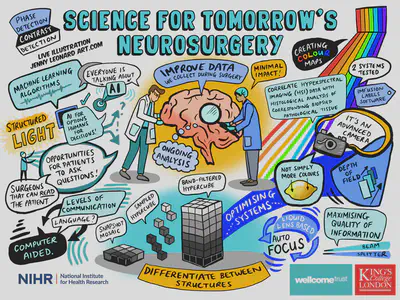Science for tomorrow's neurosurgery: Patient & Public Involvement (PPI) group - February 2023 group meeting
We are working to develop new technologies that combine a new type of camera system, referred to as hyperspectral, with Artificial Intelligence (AI) systems to reveal to neurosurgeons information that is otherwise not visible to the naked eye during surgery. Two studies are currently bringing this “hyperspectral” technology to operating theatres. The NeuroHSI study uses a hyperspectral camera attached to an external scope to show surgeons critical information on tissue blood flow and distinguishes vulnerable structures which need to be protected. The NeuroPPEye study is developing this technology adapted for surgical microscopes, to guide tumour surgery.

Both studies are guided by the Science for Tomorrow’s Neurosurgery patient involvment group, which explores the complex issues of bringing artificial intelligence and new technologies into patient surgeries. The group had its third meeting on the 10th February 2023 to discuss progress on the hyperspectral research projects, how machine learning can be used to bring complex pictures into focus for surgeons and potential opportunities for future research.
Charlie Budd, a research software engineer and Jianrong Qiu, a postdoctoral research fellow held talks on the development of autofocus systems for hyperspectral imaging. Jianrong introduced some of the hardware used – including how it is tested and validated to make sure it gives surgeons the sharpest images at the correct time, plus how researchers test new equipment in the lab to make sure it’s safe before it’s introduced into surgery. The group were particularly interested in how new hardware can be used to maximise the quality of information passed to the surgical team. Charlie discussed how artificial intelligence algorithms – particularly “neural networks” can use deep learning to predict where surgeons will need to focus and give clear images more quickly and reliably than traditional camera systems. The complex issue of communicating these developments with patients before surgery was discussed, with the point raised repeatedly that it’s important to have surgeons and clinicians that can read the patient – providing accessible information that’s relevant to their decision making in the right way at the right time.

Oscar MacCormac and Matt Elliot – clinical research fellows in neurosurgery gave an update on the progress of the Neuro HSI and PPEye studies. Oscar gave an update on the provisional results of Stage 1 of Neuro HSI, including how based on early results the team have begun to investigate how to attach the new imaging systems to surgical microscopes. This could provide a stable, non-intrusive way and safe way to image delicate brain structures during surgery. The group were very interested to see it in action in future meetings - and fully supportive of integrating it into the research. Matt gave an update on the PPEye study – detailing how use of surgical tumour samples is being used to build and calibrate hyperspectral systems to determine tumour boundaries in surgery.
Matt also gave a talk on future research work looking into different ways to use hyperspectral imaging in fluorescence guided tumour surgery- specifically looking into how best to cause tumours to give off light (fluorescence) that distinguishes them from the healthy brain. He discussed different methods currently in use to make tumour tissue glow under controlled light conditions, the affect this may have on hyperspectral camera systems and some of the challenges of testing this in a controlled manner. All agreed on the importance of testing different methods in the lab before introducing them to surgery, and different methods of testing ranging from liquid models to animal experiments were discussed. There was unanimous agreement that the methods used needed to mirror real life surgical situations as closely as possible before introducing new techniques into the operating theatre – and the group supported for using animal models for this purpose when strictly necessary.
All in the group were interested to hear how the current research work is progressing and were able to guide not only the current projects but feed into new and complementary work designed to improve patient safety and outcomes in neurosurgery!
If you have been diagnosed with, or treated for a brain tumour and would be interested in helping to guide cutting edge research in neurosurgery and AI please contact the NeuroHSI team or NeuroPPEye team to enquire about space in the Science for Tomorrow’s Neurosurgery PPI group.
To learn more about the project, please visit our neurohsi.uk and neuroppeye.uk pages.